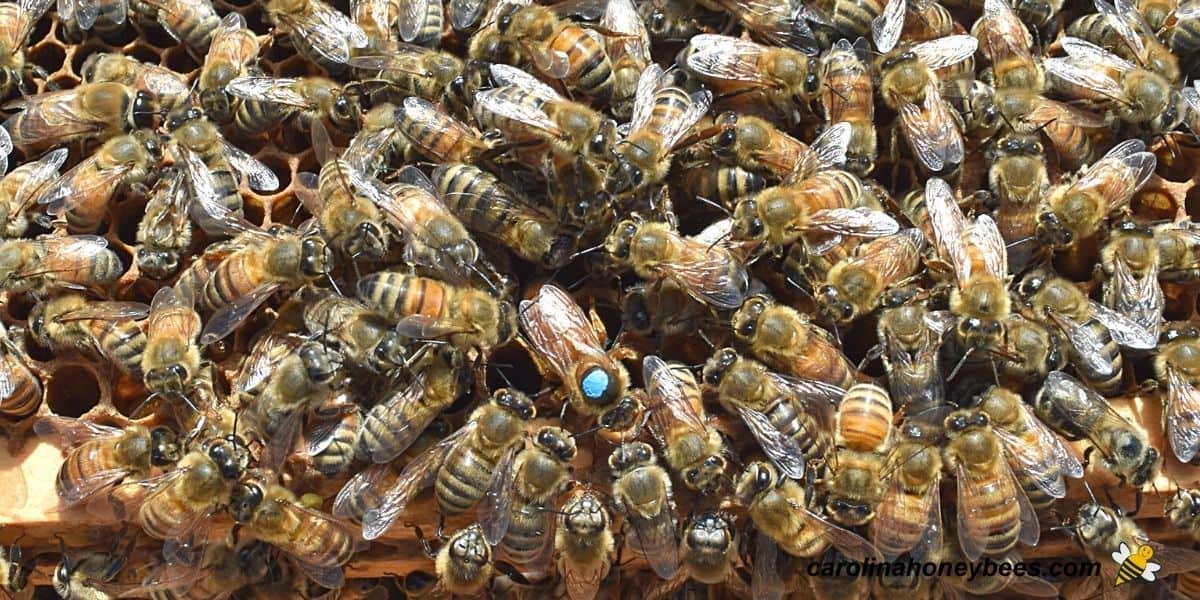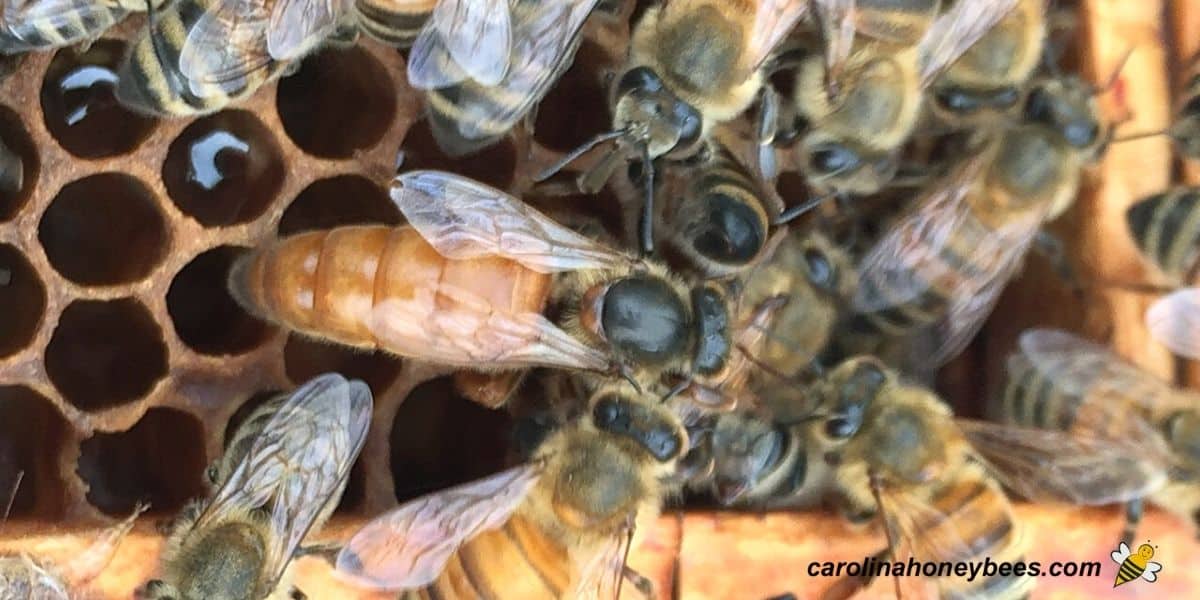Role of a Queen Bee
It takes thousands of bees to support a colony, but the role of the queen bee is essential to colony survival. She is not a bee that toils to provide resources for the hive. But, the members of the hive work to care for and protect her. What does a queen bee do? Actually, you may be surprised to learn of some of the ways her presence affects behavior of the colony.

It is important for beekeepers to understand how the individual members of the colony work together. The queen is mother to all bees in the hive. This is a well-known fact about queen bees but she is important to the colony for other reasons too.
What does the Queen Bee Do?
Sometimes it is thought that the queen is “in charge” much like a human monarch. We assume she “rules the roost”, telling all the worker bees what to do. In fact, nothing could be farther from the truth.
The queen honey bee does not make decisions for the hive. However, this does not mean that she has no affect on colony behavior.
Main Duties of the Queen Bee
In reality, the duties of a queen honey bee are few. However, none of the other females can take her place. Her main functions are:
- lays eggs – fertilized and unfertilized
- kills rival queens
- produces pheromones
Egg Laying
A queen honey bee is the only female capable of mating with drones. In honey bee reproduction, mating takes place away from the hive.
And, semen is stored in a special structure in her abdomen (spermatheca) until needed. This gives the queen the ability to lay both fertilized and unfertilized eggs.
Fertilized eggs develop into female worker bees (or a new queen if needed). Unfertilized eggs develop into drone honey bees.
Egg laying is the primary role played by a queen bee. In the warm season she can lay thousands of eggs in a day – while workers feed and care for her.

How the Queen Lays Eggs
She moves slowly across the surface of the comb – a small group of workers follow her. Her long abdomen contains mature ovaries with ripening eggs and stored semen.
- She checks the empty wax cells and measures their diameter with her front legs.
- Upon finding a clean polished cell, she lowers her abdomen into the cell and releases one egg.
- If the cell size is proper for a worker, the egg will be fertilized with semen
- If the cell size is larger, intended for a drone, she lays an unfertilized egg
(How cool is that – she can decide if she wants to have a boy or girl !) It is a simple life, but if egg laying drops, the colony of bees will kill their queen and rear a new one.
Killing Rival Queens
The queen bee stinger is different than that of workers. Her stinger is smooth instead of barbed. A queen honey bee can sting-multiple times without injuring herself.
But, she does not need to protect the hive from predators. Instead, her stinger is used to kill rival queens. When the colony rears a new queen – several queen cells are built.
The first virgin queen to emerge kills the others in their cells. The hope is that the strongest candidate will survive.
Queen Bee Pheromones
Another major role played by the queen bee is colony unity. And this is not a function that the queen does on purpose.
You can not see any physical bee characteristic that is responsible for this function of the queen – but you can see the results.
Specialized glands produce pheromones (chemical messengers -much like external hormones). A good queen has strong pheromones that promote stability in the hive.
They help identify her in the role as leader and reproductive center of the colony. QMP (Queen Mandibular Pheromone) is one of the most important bee pheromones produced.
It affects the colony in many ways and plays a role in swarming, inhibiting sexual development in worker bees, etc.

Replacing the Queen Bee
Nothing good last forever. There will come a time when the colony wants a new queen. Perhaps her egg production declines or failing pheromone production is the cause.
Once the worker bees become dissatisfied, they will begin to build queen cells. In a process called – supersedure, very young female larvae are chosen for potential new queens.
These cells are tended and the developing bee larvae inside fed for about 16 days. (egg to adult). The first virgin queen to emerge will kill her rivals. After maturing and mating, she will become the new queen.
Sometimes beekeepers want to introduce new genetics into a colony by requeening a hive. This can be done with a proper introduction phase.
How Long Does A Queen Bee Live?
While the life span of a queen can cover up to 5 years or more, she is not normally allowed to live that long.
When she begins to lag in her 2 main roles: egg laying and pheromone production, the bees will make plans to replace her.
This of course assumes that she is not killed by disease or accident. If the queen bee dies she must be replaced as soon as possible.

FAQs
A colony can survive for a short time without a queen bee, but the workers will usually attempt to raise a new queen bee as soon as possible. If a colony is unable to produce a new queen bee, it will eventually die out.
The queen’s retinue is a special group of young adult worker bees that attend to her every need. They are often seen in a circle facing her.
Yes, the queen has the capacity to fly. However, she only leaves the hive during her time of mating or later with a swarm.
Mating does not take place inside the beehive.
Approximately 7 days after emergence, the virgin queen will take several mating flights. After mating with 12-20 male drones, semen is stored inside her body.
A colony will rarely have more than 1 at a time. However, there may be times when 2 queens reside in the colony for a while. This is usually a mother/daughter pair. Eventually the new daughter will take over.
The queen can survive for a short while without workers. Usually this is a situation where a beekeeper keeps a caged queen in a temporary location. In the hive, a queen can not survive on her own.
The queen bee does not really make decisions about building up colony population. She can not lay eggs until the workers build honeycomb and clean the cells. No honeycomb, no polished cells = no eggs laid. The workers are the ones who really make most colony decisions.
Final Thoughts
As important as the queen is to the beehive, she does not make all the decisions or do the work alone. However, the role of the queen bee is one that can not be performed by any other bee in the colony. For this reason, her status as the most important bee in the hive remains secure.

